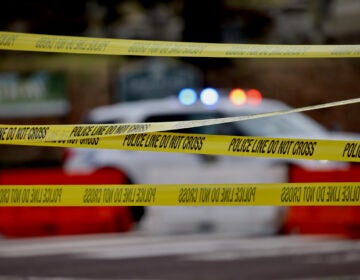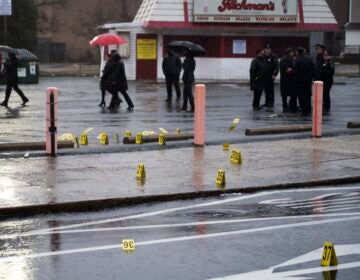What we talk about when we talk about community policing
NewsWorks hosted a public forum on Nov. 17 about the relationship between the police and the communities they serve by asking: What should the future of policing look like?
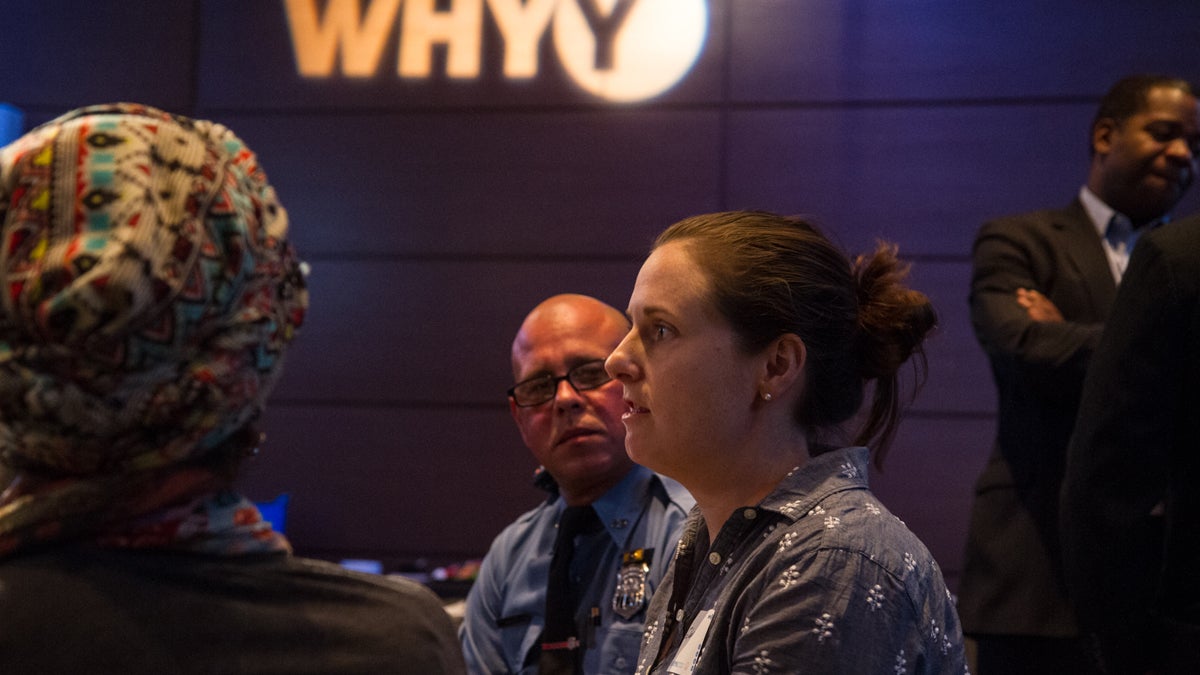
Neighborhood leaders, city employees, a few police officers, and citizens who simply wanted to learn more attended a community policing forum at WHYY on Nov. 17. (Ifanyi Bell/for NewsWorks)
NewsWorks hosted a public discussion on Nov. 17 about how to strengthen the relationship between the police and the communities they serve by asking: What should the future of policing look like?
Guests were encouraged to share their personal stories in an effort to identify opportunities to improve public safety and cooperation. The discussion was largely optimistic. Dr. James Peterson, host of WHYY’s “The Remix” podcast, led the conversation.
A panel of four started discussions off, including neighborhood leaders LaVeta Jones (Mount Airy), Tyrone Wrice (Mantua), and Amelia Price (Tioga), as well as outgoing Philadelphia Deputy Commissioner Kevin Bethel.
A key theme of the evening was the responsibility on the part of both the police department and community members to work toward solutions through interaction and dialogue. It’s not just about crime fighting, it’s also about building relationships.
Another recurring realization is that what residents want from community-police relations differs by population and by neighborhood. It’s hard to define community policing. One participant said this is a good thing, because it means that anyone with a heart is qualified to help keep their community safe.
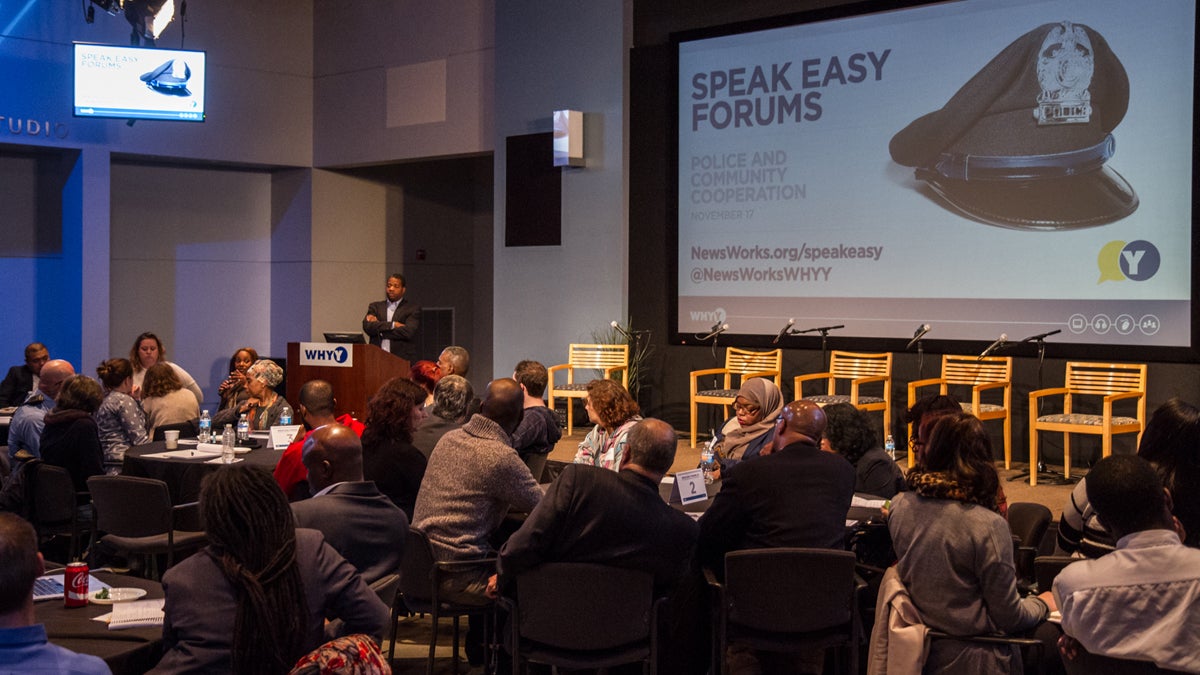
Here are some ideas that came up in group discussions.
Community cohesiveness, vigilance
- Effective policing starts with investing in the community, being vigilant. For example, neighbors can be on the lookout for women walking home late from work.
- Neighbors have to be connected with each other. It’s important to attend meetings, exchange phone numbers, and get to know people.
- One participant spoke about parents in Mantua, Philadelphia, encouraging younger people to help keep the neighborhood clean as a version of community policing. In Mantua there is poverty, and there is pride, he said. Having opportunities to engage with police officers as a kid gave him an appreciation of police officers and the work they do.
- Children are watching the adults in their community. If neighbors and police don’t come to terms, the kids will carry those prejudices forward.
- The burden is on neighbors to document crimes to make them “real issues.”
Interactions affect perceptions
- Cops are often seen as a bad thing, outsiders, not a part of the community. Working one on one with police helps to change perceptions.
- When police keep their promises and when they use de-escalation strategies, they can gain community trust.
- One participant spoke of an officer-involved shooting last year. Neighbors asked the police very hard questions, but because of the existing positive relationship, they were more willing to wait for formal resolution to the situation. In a situation like this, that resolution — how it is arrived at, and how it is communicated to the public — is essential to inspire trust.
- Panelist Tyrone Wrice told a story about being attacked by a police dog when he was young. The police commissioner at the time, Frank Rizzo, who was not loved among African-American communities, visited to see how he was and to apologize for the incident. Wrice said he has a fear of dogs to this day, but as a result of Rizzo’s actions, he didn’t leave that incident fearing or hating police.
- One participant described an experience as a teenager when police pulled him and a friend off of a SEPTA bus to take him to a McDonald’s that had just been robbed. The manager said immediately that it was not him. It was another black man, who otherwise looked nothing like him. “Why do they do that?” he said.
- A woman from Southwest Philly talked about calling the police to help with a problem in her neighborhood. Neighbors went with her to the district headquarters to identify the perpetrator, and she gained an appreciation for the police because of their help.
- One participant who frequently connects with the court system for work said she has seen officers change their stories while on the witness stand to justify an illegal search — which leads to a community’s distrust of the police. This is one reason kids are taught to run or walk away from the police.
- A young black man described positive interactions with police after being mugged twice. Their responsiveness and the accuracy of their report made him feel better about what had happened, that he was able to do something about it.
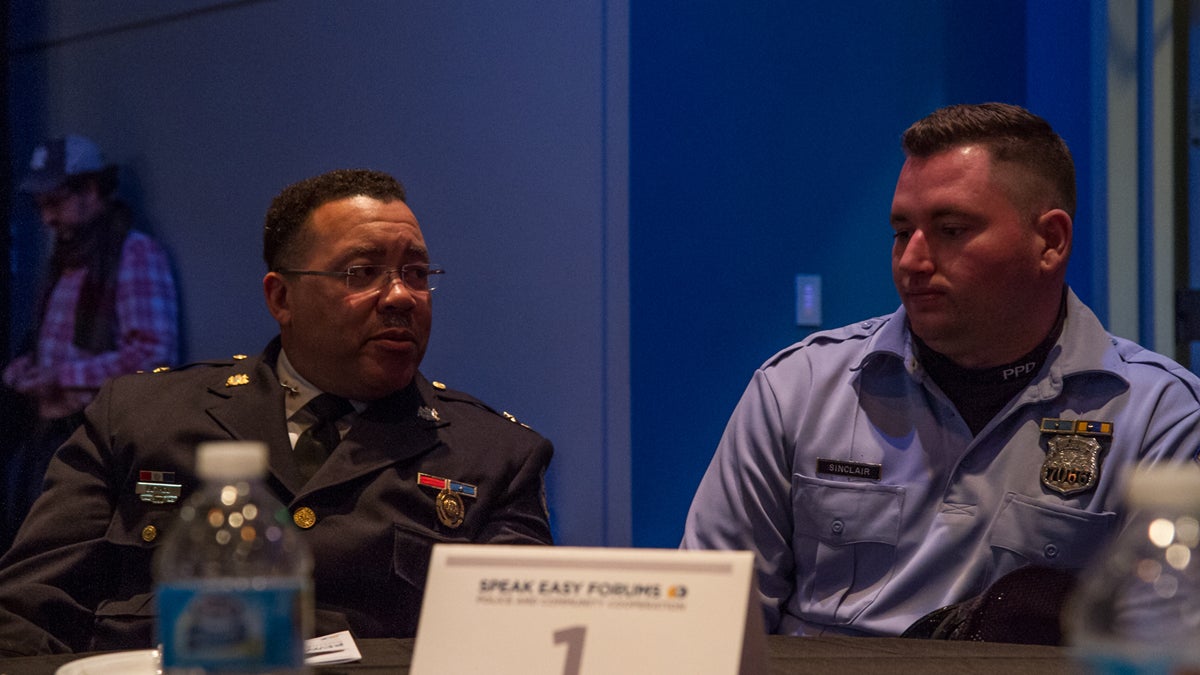
What police see
- One attendee asked what influences police’s perception of the community. Some acknowledged that police can have lower expectations of certain communities. Their training influences what they see and how they interpret it.
- Their experience colors their view, because they have to protect themselves and others. They are always on guard.
- Police need to learn to ask themselves: “How do I walk into this situation and not buy into what I am seeing?”
- Residents need to figure out how to get police officers to see what is possible in a neighborhood instead of the existing problems. More planned, positive interactions will help them see the good in a community — seeing and meeting “good people” in the community, e.g., elders, Town Watch members, church leaders, neighborhood activists.
- Rotating officers to different districts and neighborhoods can keep them from getting jaded from repeated interactions with the same “bad people” — but it can be disruptive to relationship-building.
- An officer in attendance said that 90 percent of calls are for domestic violence. People don’t know how to talk to each other. Cops mediate conversations. They have a new form for reporting incidents of domestic violence that requires a lot of questions. More information can lead to better responses and gives them more process, more opportunities for follow-up, closer involvement.
- An officer described a situation when he encountered a man who appeared to be doing drugs. Instead of arresting him, he talked to the guy about how he might change his life. “It’s not about how many pinches you get,” he said, but rather how you build trust with the people you serve.
- I became a police officer because I wanted to help people, an officer said. I get more than I give.
- It’s important for police to see what people are talking about in the community. An officer said he tried to see what residents are seeing by going out to the field. Sometimes people don’t report minor crimes in high-crime neighborhoods, but those issues, which might still be major concerns for some, could more easily be fixed. It’s important for neighborhoods to communicate their needs to the police.
- Witnessing violence results in trauma every day. If trauma is not dealt with, it can lead to aggression. What can we do to deal with this? We all have trauma — we lose neighbors, police lose partners. I get nightmares. If people knew what I see, they may not keep calling me names.
- A participant said that the police department should ensure that there is a decompression routine built into training and support services. The department should provide mental health first aid, and behavioral and mental health training, for police — and broadcast that such training is available.
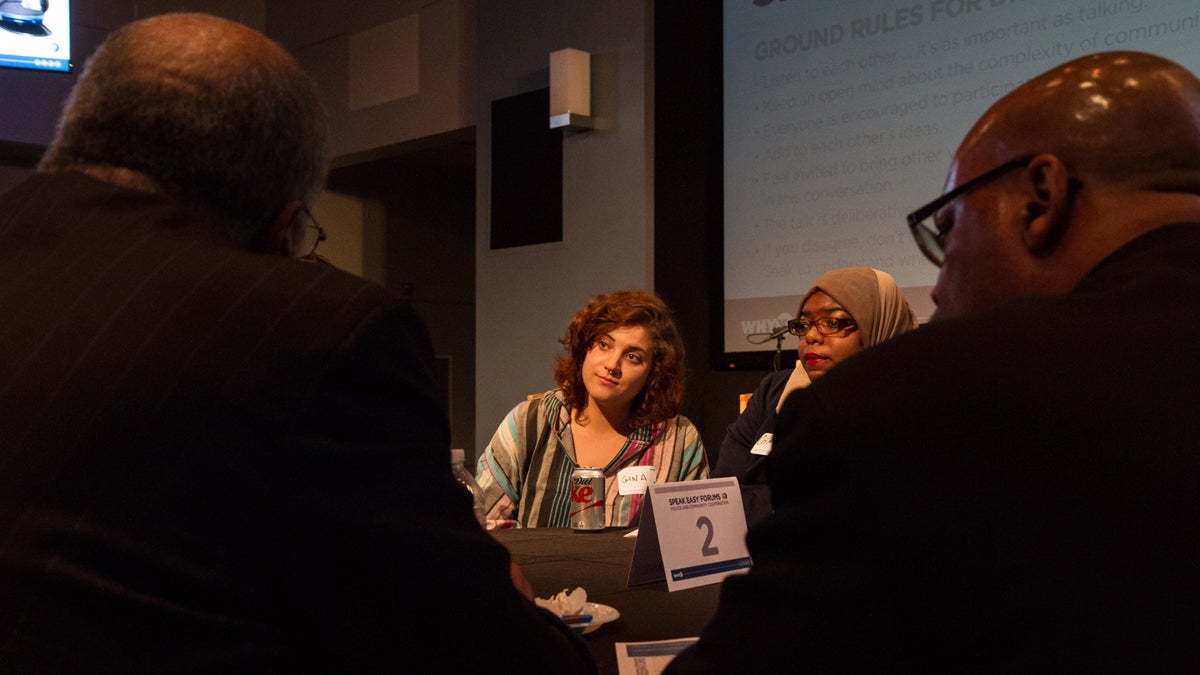
Impediments to positive interaction
- Because of their visibility and ubiquity, police often bear the brunt of social issues that they might be be able to fix , e.g., race, poverty, poor government.
- Police have an overwhelming job, both in terms of the number of calls they have to respond to and in terms of the social work tasks asked of them — mental health counseling, family counseling, domestic violence counseling.
- Lack of continuity is a problem. It often takes a couple of years for relationships to gel. Also, relationships come “from the top.” Police officers move around a lot from district to district. The captain is there longer, so building a relationship with the district captain is important. So it can be helpful to go even higher. Build a relationship with your state representative. Panelist LaVeta Jones said Rep. Cherelle Parker has provided continuity and leverage to ensure the police district is consistent in their efforts to work with the community.
- Community meetings need to be a priority. Where and when they occur is not always made clear to neighbors. Often the police officers themselves do not know about them or do not share information.
- A participant who works at Women Against Abuse said the panelists’ positive experiences of community relations are different from what she hears working with victims of crimes. Many victims don’t take the steps — or even have access to those steps — to create positive police relationships.
- In large cities, opportunities for one-to-one relationships between community members and police officers can be limited.
- Some who want to have a healthy relationship with the police may be scared, because doing so can raise suspicion among neighbors and get them labeled as a snitch. One South Philly woman said that she doesn’t always call the police right away to deal with neighborhood issues like drugs and prostitution. She calls her brothers, who are police officers, or she goes to the district to report it instead.
- A resident in East Falls saw surveillance cameras appear without anyone in the community being asked if they wanted them or, if they did, where to put them. Some residents called about the cameras, and the people at the other end didn’t know anything about them.
- There are so many different police departments throughout Philadelphia — city, university police, SEPTA, Philadelphia police, federal officers, even store security — and there is no unifying approach.
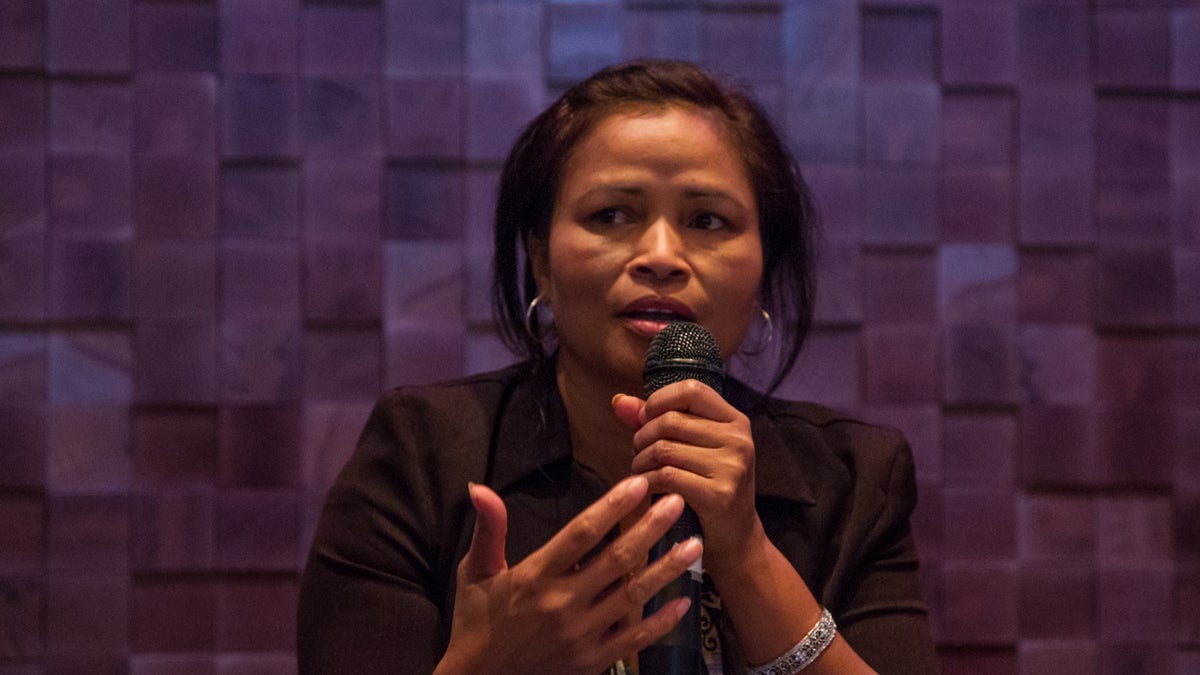
Immigrant perspectives
- A woman representing South Philly’s South Asian immigrant community had a couple of points from the “limited English-speaker perspective.” Language assistance is important. There is a segment of the city that is overlooked and living on the fringes, scared to talk to police because they don’t know how to.
- Immigrants also face fears of incrimination, of being profiled, of being deported. “You can be deported, even if you’re a legal immigrant, for carrying two pills of ecstasy when you’re 19 years old.” Refugees can be sent back to the countries they tried to escape from.
- It’s important to have police who look like us, she said. There should be more active outreach and recruitment for police officers who can communicate with and relate to immigrants. if you have drugs on you.
Ways of supporting interaction, collaboration
- When we open up the conversation, cops become more approachable. The stereotype is that police don’t listen, if we can listen, we can work together. With a more open dialogue, people will realize they can go to the police and not be afraid of what the response might be.
- Police do not snitch on each other. Holding police accountable for misconduct can build community trust, help residents recognize the role of authority in police. Healthy community relationships are valuable for both police and community members.
- Police won’t mistreat you if they know you, said one African-American man. He said he isn’t afraid of the police in his own community, but rather the police in other communities.
- Foot patrols are a big help toward building trust and an important way for officers to get a realistic view of about what being in a community is like. Deputy Commissioner Kevin Bethel indicated that this kind of training is happening in only six out of 21 patrols in Philadelphia. He said that motorizing the police force helped speed their response, but also lost some personal interactions along the way.
- A police officer in attendance shared how much relations are changing between police and civilians. There are more forums, more people coming out, and more collaboration between community leaders and police.
- There needs to be work on both sides to close the communication gap. Residents must report problems to the police, and police and community leaders must share more about what’s being done. Neighbors ask police for help all the time, but the police need help from people in the community too.
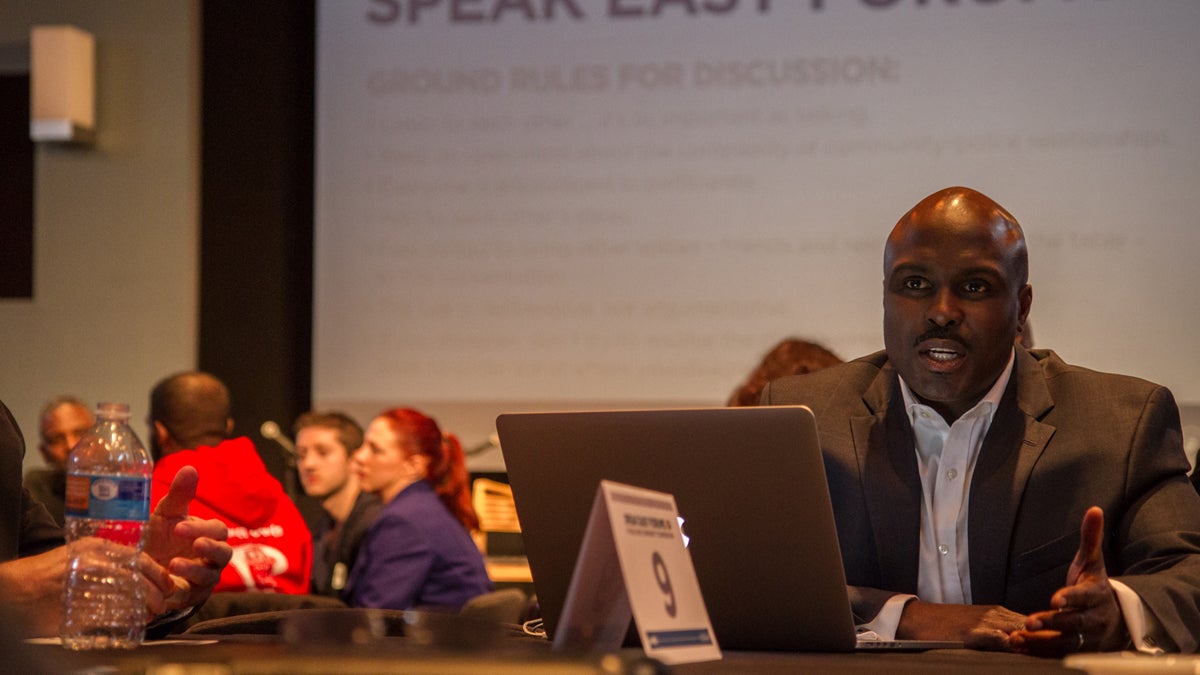
The role of news media
- Positive interactions happen all the time, but there is a perception that they are not getting enough attention in the news media. The focus tends to be on the volatility of individual situations, and not on big-picture positive efforts. Maybe the negative stories stand out more or simply reinforce the pessimistic narrative that people expect.
- News media should make an effort to focus on positive, solution-oriented stories. For example, there have been 1,500 – 2,000 officers trained in conflict resolution and de-escalation strategies. Reporters should talk to rank and file officers about what works.
- There’s a role to play in helping the community understand the role of the police department.
- Great community-policing work is being done in business corridors, for example the SafeGrowth “crime prevention through environmental design” program at work in eight neighborhoods throughout the city.
Participant suggestions
- The community has to reach out to the police and ask them for participation, begin two-way communication.
- There should be major community events in each police district several times a year to build and mend relationships between neighbors and cops — events with schools and children, especially.
- The police department needs a marketing campaign that includes different levels within the force and sets a more positive direction for how the community perceives police, to rebrand police as caregivers to communities.
- Investigations into inappropriate behavior should be sped up, and the department should be transparent about the consequences, making it clear that misconduct will not be tolerated.
- Set up a mixed-race mentor program to break down cultural divides.
- Create or enforce a policy that allows police officers to explain why they are stopping someone.
- Some suggested a top-to-bottom evaluation of the entire police force.
- Rotate police officers among districts so they are exposed to different people throughout the city, but keep the district leadership in place to maintain consistency.
- Transitions of officers and leadership should be planned, phased-in and gradual. Communities need time and a process to say goodbye to people they have gotten to know, and to be introduced to new officers and district leadership.
—
We take very seriously the idea of giving space to people to tell their own stories, and for giving others an opportunity to hear them. Submit a 700-word personal essay, commentary or op-ed to Speak Easy for consideration. Email speakeasy@whyy.org.
Special thanks go to discussion moderators from the Penn Project for Civic Engagement, including Marjorie Anderson, Brian Armstead, Gina Cappelletti, Randy Duque, Ellen Greenberg, Germaine Ingram, Ellen Petersen, Roz Spigel, Terril Thompson, and Josh Warner for their contributions to this report.
WHYY is your source for fact-based, in-depth journalism and information. As a nonprofit organization, we rely on financial support from readers like you. Please give today.



